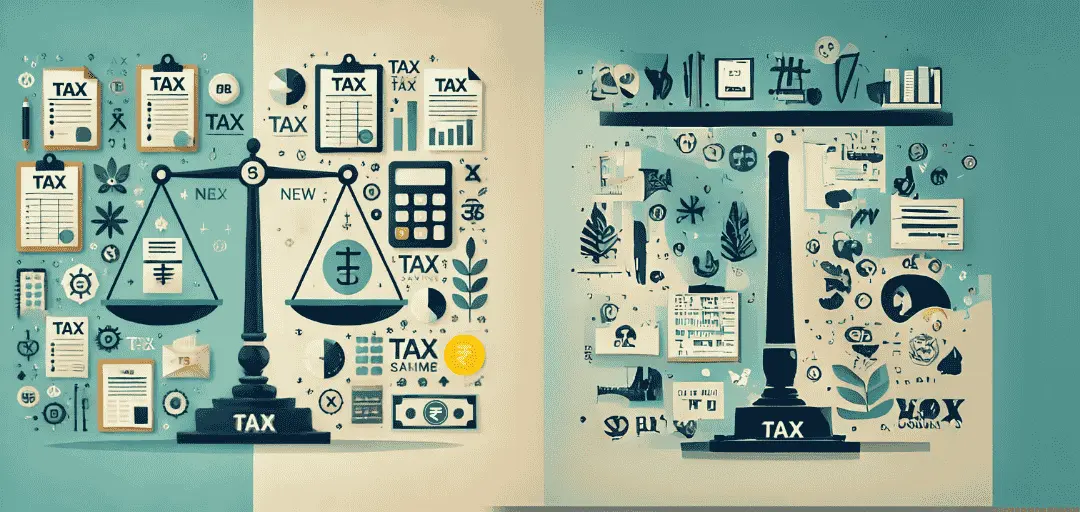Old vs. New Tax Regime: Which One Should You Choose?
Taxpayers in India often face a dilemma when choosing between the old vs new tax regime. With the introduction of the new tax regime in Budget 2020, the government aimed to simplify the tax structure by reducing tax rates while eliminating most deductions and exemptions. However, the old vs new tax regime still holds significance for those who wish to maximize their deductions. So, which one is better for you? In this blog, we will analyze the key differences between the old vs new tax regime and help you make an informed decision.
Understanding the Old vs New Tax Regime
The old vs new tax regime allows taxpayers to claim multiple deductions and exemptions under sections such as 80C, 80D, and HRA. These deductions help in reducing taxable income significantly, making it beneficial for those who invest in tax-saving instruments.
On the other hand, the new tax regime offers reduced tax rates but eliminates most deductions and exemptions. It is designed for taxpayers who prefer a simplified tax structure without the hassle of maintaining investment proofs and paperwork.
Tax Slab Comparison: Old vs New Tax Regime
The primary difference between the two regimes lies in the tax slabs and rates:
| Income Slab (Annual) | Old Tax Regime (With Deductions) | New Tax Regime (Without Deductions) |
|---|---|---|
| Up to 2.5 lakh | Nil | Nil |
| 2.5 lakh – 5 lakh | 5% (with rebate under 87A) | 5% (with rebate under 87A) |
| 5 lakh – 7.5 lakh | 20% | 10% |
| 7.5 lakh – 10 lakh | 20% | 15% |
| 10 lakh – 12.5 lakh | 30% | 20% |
| 12.5 lakh – 15 lakh | 30% | 25% |
| Above 15 lakh | 30% | 30% |
As seen in the table, the new tax regime offers lower tax rates; however, it does not allow popular deductions such as 80C (₹1.5 lakh for investments like PPF, ELSS, and LIC), 80D (health insurance), and HRA (House Rent Allowance), which are available in the old vs new tax regime.
Benefits of the Old Tax Regime
Tax Deductions and Exemptions: You can claim various deductions under sections 80C, 80D, HRA, LTA, and other exemptions that reduce taxable income.
Encourages Savings and Investment: Investment in PPF, EPF, NSC, and life insurance helps in wealth accumulation over time.
Ideal for Individuals with High Deductions: If you have multiple tax-saving investments, the old vs new tax regime can help reduce your tax liability significantly.
Benefits of the New Tax Regime
Simplified Taxation: No need to maintain proof of investments or file for deductions, making tax filing hassle-free.
Lower Tax Rates: Suitable for individuals who do not claim many deductions but want lower tax rates.
Higher Take-Home Salary: Since no deductions are required, salaried individuals can enjoy a higher in-hand salary without locking funds into tax-saving instruments.
Who Should Choose the Old Tax Regime?
Individuals with high tax-saving investments under 80C, 80D, and HRA.
Salaried employees who receive allowances such as LTA, HRA, and education allowance.
Taxpayers who prefer structured savings through tax-exempt investment schemes.
Who Should Choose the New Tax Regime?
Individuals with minimal investments in tax-saving instruments.
Young professionals who want a higher take-home salary rather than long-term tax benefits.
Freelancers and self-employed individuals who do not have significant deductions.
Which One Should You Choose?
The choice between the old vs new tax regime depends on individual financial situations. If you are someone who actively invests in tax-saving options and claims multiple deductions, the old vs new tax regime might be beneficial. However, if you prefer a straightforward tax system with lower tax rates, the old vs new tax regime is a better choice.
Before making a decision, use an income tax calculator to compare the total tax liability under both regimes and choose the one that best suits your financial goals.
Conclusion
The debate of old vs new tax regime is ongoing, but the ideal choice depends on your income, investment habits, and financial goals. The old vs new tax regime favors disciplined investors who seek long-term savings, while the old vs new tax regime benefits individuals who want simplicity and higher liquidity. Evaluating both options carefully will help you optimize your tax savings and financial planning.
Which tax regime do you prefer? Let us know in the comments!
Our GST Services

All E-commerce Tax services
E-commerce tax services help online sellers navigate GST registration, compliance, return filing, TCS management, tax planning, and audits, ensuring efficient tax management and legal compliance.

GST Filing
GST filing is the process of submitting tax returns to the government, detailing sales, purchases, and taxes paid or collected, ensuring compliance with GST laws.

GST Registration
GST registration is the process where businesses obtain a GSTIN from the government, allowing them to collect taxes, claim input tax credits, and comply with GST laws.





